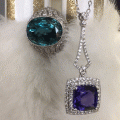December Birthstones: Tanzanite, Zircon, and Turquoise
The December birthstones are the perfect match for the winter month with their deep and beautiful blue hues. The gems range from the oldest on earth (Zircon), to one of the first mined and used in jewelry (Turquoise), to one of the most recently discovered (Tanzanite).
No matter your style or budget, one of these three gorgeous December birthstones will match your desires.
Tanzanite Jewelry
Tanzanite is a rare blue variety of the mineral zoisite, which is only found in one part of the world – Tanzania. Since its discovery in 1967, it quickly has risen in popularity and even became a December staple. This is largely in part due to Henry Platt of Tiffany and Co. naming the new gem “tanzanite” and starting a marketing campaign to introduce it to the public.
Tanzanite is sometimes used as a sapphire substitute, although it is not quite as strong – measuring a 6.5 to 7 on the Mohs scale of hardness. Given this, tanzanite is typically used for earrings and pendants rather than rings.
What Does Tanzanite Symbolize?
Because tanzanite is a relatively modern gemstone, it doesn’t have as much history and lore as some other birthstones. However, some believe the stone to transform negative energies, boost self-manifestation, dispel lethargy and strengthen the immune system.
Zircon Jewelry
Zircon is an underappreciated gem, partly due to its name which easily gets confused with cubic zirconia. However, this beautiful natural gem (which is the oldest mineral on earth) comes in a variety of colors, spanning red, orange, yellow, green, blue and brown.
Zircon is commonly found in brownish red, which is a popular option for earth-toned jewelry. Blue zircon, which is the most popular color, is the alternative birthstone for December.
Zircon measures 7.5 on the Mohs scale of hardness.
What Does Zircon Symbolize?
Zircon is the oldest mineral on earth, dating back more than 4.4 billion years.
During the Middle Ages, people believed that zircon can induce sleep, ward off evil and promote prosperity.
Blue zircon in particular was very popular during Victorian times and was often found in English estate jewelry in the 1880s.
Today, zircon is known as a grounding stone that increases confidence and compassion. Similarly to tanzanite, it is said to help bring your visions into reality and guide you to achieve your goals.
Turquoise Jewelry
Turquoise is known for its distinct color that ranges from powdery blue to greenish robin’s egg blue. Some turquoise contains pieces of host rock, which appear as dark webs or patches in the material. A uniform “spiderweb” pattern of Southwestern turquoise is considered very attractive.
Turquoise is sensitive to direct sunlight and solvents like makeup, perfume and natural oils. At its hardest, turquoise only measures 6 on the Mohs scale, which is why the soft stone was so popular in carved talismans throughout history.
What Does Turquoise Symbolize?
From ancient Egyptians to Persians, Aztecs and Native Americans, kings and warriors alike have admired turquoise for thousands of years. It adorned everything from jewelry to ceremonial masks to weapons and bridles.
Throughout time, turquoise was believed to provide protection and grant power. Persians wore turquoise jewelry around their necks and in their turbans. They believed it offered protection by changing color to warn of pending doom. (Turquoise can, in fact, fade if exposed to sunlight or solvents.)
Later, Native American shamans used the stone in sacred ceremonies to commune with the spirit of the sky. Turquoise became valuable in Native American trade, which carried North American material toward South America. Consequently, Aztecs cherished turquoise for its protective power, and used it on ceremonial masks, knives and shields.
Are you searching for a unique piece of tanzanite, zircon, and turquoise jewelry? Call Victoria Jewelers at (407) 895-0047 or contact us online today to learn more about our custom jewelry process and how we can create a beautiful piece of jewelry designed just for you.






